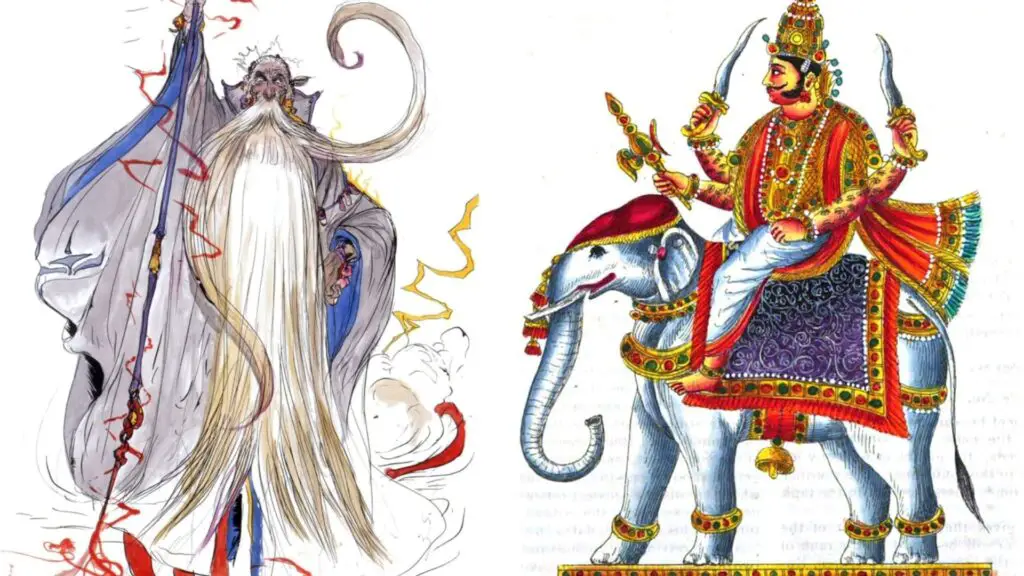Ever since the release of Final Fantasy III for the Famicom in 1990, summons have been an iconic part of the series, allowing players to conjure magical creatures to devastate their enemies. Many such as Ramuh, Shiva, and Ifrit have made regular appearances throughout the series. But, have you ever stopped to wonder where these fantastical beings came from? The truth is that most Final Fantasy summons are directly based on figures from mythology and history. In this article, we will be looking at 10 of the most iconic summons from throughout the series to discover their origins.
Ifrit

Ifrit (also known as Jinn or Ifyte) is the iconic fire summon from the Final Fantasy series. First appearing in Final Fantasy III, Ifrit draws from Arabic mythology. In Islamic folklore, the Ifrit are a race of Jinn known for their rebelliousness, violence, and cruelty. They are oftentimes portrayed as having red or orange skin, with firey eyes. They are known to inhabit desolate places such as ruins and temples and are said to possess control over fire. Square did not change much when incorporating these creatures into their series.
Shiva

Shiva is the iconic ice summon. After her debut in Final Fantasy III, she has made regular appearances in nearly every major entry in the Final Fantasy series. She seems to be inspired by the Hindu deity of the same name. In Hinduism, Shiva is the god of destruction and is one of the 3 primary deities in charge of maintaining the world along with Brahma the creator, and Vishnu the preserver. It is said that his skin turned blue after he consumed poison to save the world. While the Shiva from Hinduism is male, he has had several female avatars. While in these forms he is known to spend much of his time in the snowy Himalayan mountain ranges, which is likely where the summon’s association with snow and ice originates.
Ramuh

Ramuh (also sometimes called Indra) is the lightning summon of the Final Fantasy series who first made his debut in Final Fantasy III. Ramuh seems to be based on several figures from Hindu mythology. While he is primarily inspired by the Hindu storm god Indra, his name is more than like likely based on that of Rama: the seventh avatar of Vishnu.
Bahamut

Bahamut has undergone one of the most drastic transformations between his mythological origin and his appearance in the Final Fantasy series, that of a powerful dragon king. His debut actually predates Summoning in the series, making his first appearance as a major NPC in the very first Final Fantasy who offered to upgrade the classes of the heroes if they could complete the trials of Mount Ordeals. He was heavily inspired by the good Dragon God from the tabletop game Dungeons & Dragons. Bahamut first appeared in that game in the supplement Grayhawk from 1975, where his appearance was based on that of dragons from European folklore. His name, however, is based on that of the much older sea monster from Arabian folklore. Often portrayed as a giant fish, this version of Bahamut plays a crucial role in the support structure that holds the earth. He is said to swim in the great sea which surrounds the world carrying the bull Kuyutha on his back, who in turn carries a slab of gemstone, upon which stands an angel who carries the entire world upon his shoulders.
Odin

Odin was one of the original summons from Final Fantasy III, and has since made regular appearances throughout the series. He is obviously based on the diety of the same name from Norse mythology. Known as the all-father, Odin is the king of the Aesir and ruler of the 9 realms. He is the god of war, death, and wisdom. He rides into battle atop his 6-legged steer Sleipnir and wields the spear Gungnir. Square did not change much when bringing him to the Final Fantasy series, though one curious change is how in many games he is seen wielding a sword instead of his iconic spear.
Titan

As with many other iconic summons, Titan originated from Final Fantasy III and then later made regular appearances throughout the series. He is clearly based on the Titans from Greek mythology. The children of Gaia and Uranus, the Titans were a race of deities known for their immense strength. They once ruled the cosmos after their king Chronos overthrew his father Uranus, only to eventually be overthrown themselves by the Olympians led by Chronos’ son Zeus, after which they were cast into the pit of Tartarus for all eternity.
Leviathan

Leviathan is a large sea serpent who first made his debut in the Final Fantasy series in Final Fantasy II, where he consumes a ship carrying the party. He then returned as a summon in later entries starting with Final Fantasy III. Leviathan originates from Jewish mythology and is referenced numerous times throughout the old testament of the bible, most notably in the Book of Job. A monster that roams the sea, Leviathan is often portrayed as an embodiment of primordial chaos who eats the damned before eventually being killed by God. This story is likely based on an older Canaanite myth about a monster called Lotan which was killed by the Storm god Hadad. This in turn may have been based on the much older Indo-European myth of a storm god who battles a great serpent-like creature.
Alexander

Alexander made his debut in Final Fantasy VI and has since then made repeat appearances throughout the series. The name Alexander is Greek and means “defender of men.” Most notably it was the name of the 4th century BC Macedonian conqueror Alexander the Great. The summon Alexander is likely based on a myth about the legendary gates of Alexander, which were said to have been raised by summoned djinn to defend Alexander’s empire from the savage tribes of Gog and Magog. It might also be based on the great city of Alexandria which housed two of the seven wonders of the world.
Phoenix

The iconic firebird Phoenix was originally planned to appear in the very first Final Fantasy and can be seen in concept art but never made it into the final game. Then it was later planned to be an enemy in Final Fantasy III, but while data for it can be found in the game’s code, it never actually appeared in-game. Finally, Phoenix would make his debut as a summon in Final Fantasy V and would continue to make regular appearances throughout the series. The Phoenix is a creature from Greek mythology (although Egyptian and Persian mythology also have similar creatures). It is said that when the Phoenix dies it bursts into flames and is reborn from the ashes. This is intended to represent the cyclical nature of the sun.
Gilgamesh

Gilgamesh was originally a reoccurring mini-boss from Final Fantasy V, before then becoming a summon in Final Fantasy VI. Gilgamesh is the semi-mythical king of ancient Sumeria from the Epic of Gilgamesh; the oldest surviving piece of literature in the world. Many historians believe that he might have been a real person who lived between 2500 and 2800 BC. His epic tells of his tragic friendship with the wild man Enkidu, after his friend’s death Gilgamesh has an existential crisis that leads him to a doomed quest for immortality. The Final Fantasy version of Gilgamesh is also partially based on the Japanese folkloric figure Benkei; a warrior monk said to have lived in the Heian period from 1155 to 1189 AD.






